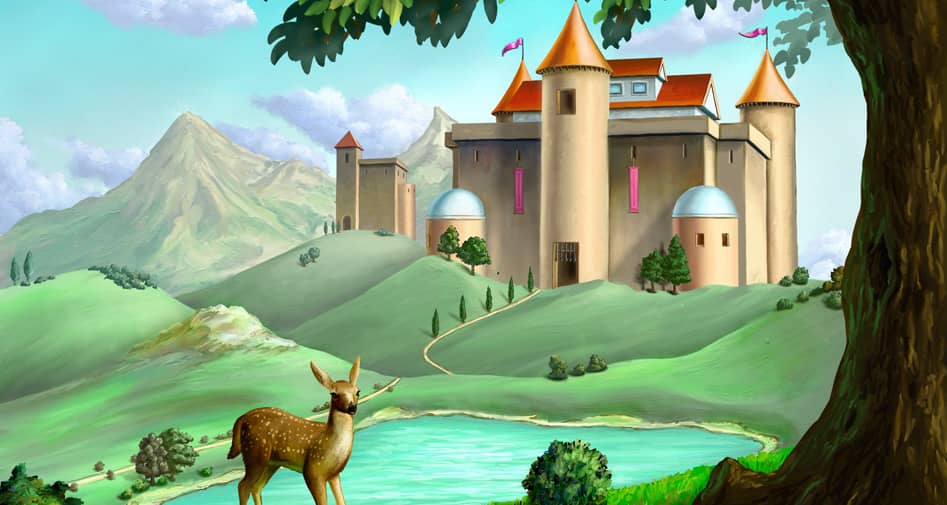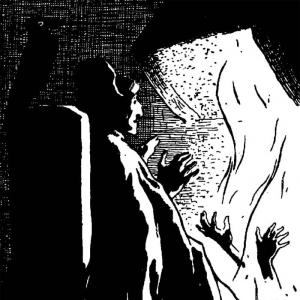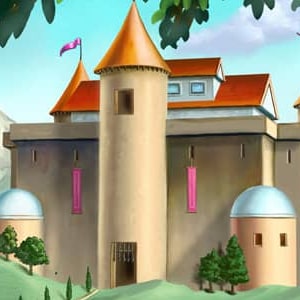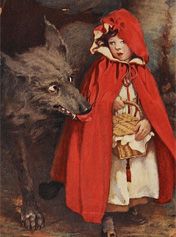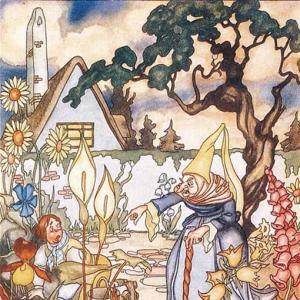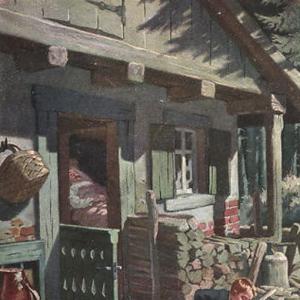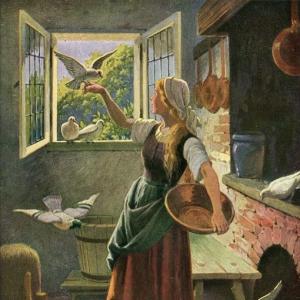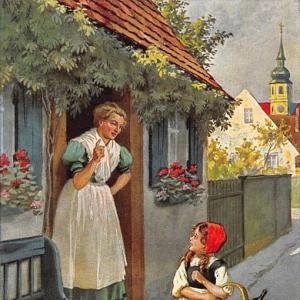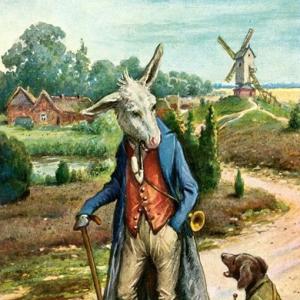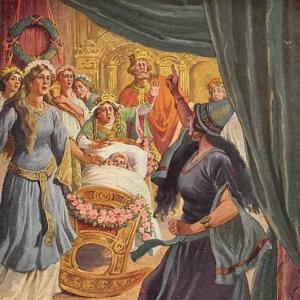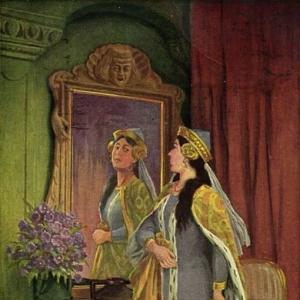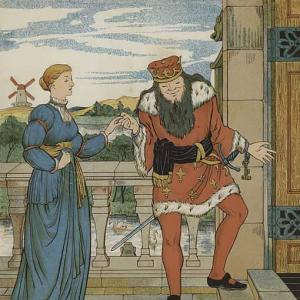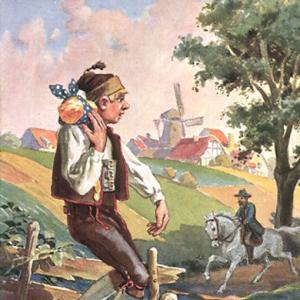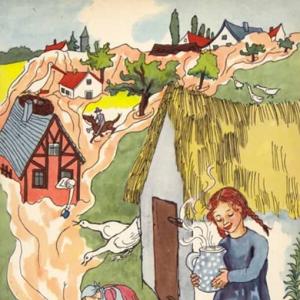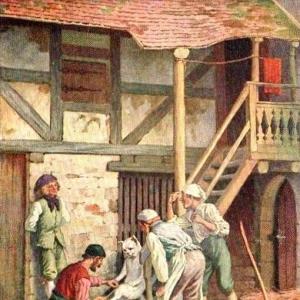Reading time for children: 4 min
Three hundred years before the birth of the Lord Christ, there lived a mother who had twelve sons, but was so poor and needy that she no longer knew how she was to keep them alive at all. She prayed to God daily that he would grant that all her sons might be on the earth with the Redeemer who was promised. When her necessity became still greater she sent one of them after the other out into the world to seek bread for her. The eldest was called Peter, and he went out and had already walked a long way, a whole day’s journey, when he came into a great forest. He sought for a way out, but could find none, and went farther and farther astray, and at the same time felt such great hunger that he could scarcely stand. At length he became so weak that he was forced to lie down, and he believed death to be at hand. Suddenly there stood beside him a small boy who shone with brightness, and was as beautiful and kind as an angel. The child smote his little hands together, until Peter was forced to look up and saw him. Then the child said, „Why art thou sitting there in such trouble?“ – „Alas!“ answered Peter, „I am going about the world seeking bread, that I may yet see the dear Saviour who is promised, that is my greatest desire.“ The child said, „Come with me, and thy wish shall be fulfilled.“ He took poor Peter by the hand, and led him between some cliffs to a great cavern. When they entered it, everything was shining with gold, silver, and crystal, and in the midst of it twelve cradles were standing side by side. Then said the little angel, „Lie down in the first, and sleep a while, I will rock thee.“ Peter did so, and the angel sang to him and rocked him until he was al seep. And when he was asleep, the second brother came also, guided thither by his guardian angel, and he was rocked to sleep like the first, and thus came the others, one after the other, until all twelve lay there sleeping in the golden cradles. They slept, however, three hundred years, until the night when the Saviour of the world was born. Then they awoke, and were with him on earth, and were called the twelve apostles.
 Learn languages. Double-tap on a word.Learn languages in context with Childstories.org and Deepl.com.
Learn languages. Double-tap on a word.Learn languages in context with Childstories.org and Deepl.com.Backgrounds
Interpretations
Adaptions
Summary
Linguistics
„The Twelve Apostles“ is a lesser-known fairy tale collected by the Brothers Grimm, Jacob and Wilhelm, who were German academics, philologists, cultural researchers, and authors. The tale is part of their collection called „Kinder- und Hausmärchen“ (Children’s and Household Tales), which was first published in 1812. The collection went through multiple revisions and editions, with the final version published in 1857.
The Brothers Grimm collected and documented numerous German and European folktales, legends, and oral traditions, in an effort to preserve the cultural heritage of their homeland. Their work has had a significant influence on the development of the fairy tale genre, and their stories have been adapted into various forms of literature, theater, and film.
„The Twelve Apostles“ is a brief, symbolic story that combines elements of Christian beliefs, such as the birth of Christ and the role of the twelve apostles, with the classic fairy tale structure, including themes like poverty, destiny, and divine intervention.
Though it is not as widely known as some other Grimm stories, like „Cinderella,“ „Snow White,“ or „Hansel and Gretel,“ „The Twelve Apostles“ still offers a unique perspective on faith and the fulfillment of destiny.
„The Twelve Apostles“ can be interpreted in various ways, touching on themes of faith, hope, divine intervention, and the power of destiny.
Faith and hope: The mother’s unwavering faith and hope in the promised Redeemer are central to the story. Her prayers and belief that her sons will be part of a greater plan demonstrates the power of faith in difficult times.
Divine intervention: The angelic children, who guide each brother to the cavern and care for them, represent divine intervention. The story emphasizes that during challenging times, divine forces may guide and protect people, helping them fulfill their destinies.
The power of destiny: The twelve brothers, despite their poverty and hardships, ultimately fulfill their destiny by becoming the twelve apostles. The story illustrates that a person’s path in life may be predestined, and despite the difficulties faced, their true purpose will eventually be realized.
The importance of patience and perseverance: The brothers‘ journey to the cavern and their 300-year slumber showcase the importance of patience and perseverance in achieving their ultimate goal. The story suggests that enduring hardships and waiting patiently may eventually lead to a reward or the fulfillment of a dream.
Unity and brotherhood: The tale also highlights the theme of unity and brotherhood among the twelve siblings. They share a common goal, and although they embark on their journeys separately, they are all eventually united in the golden cavern. Their shared experience and destiny strengthen their bond, symbolizing the importance of familial ties and support.
„The Twelve Apostles“ is a popular fairy tale that has been adapted into various forms of media over the years. Here are some examples of adaptations.
Film adaptations: „The Twelve Brothers“ is a 1956 East German film directed by Werner Jacobs, and „The Twelve Dancing Princesses“ is a 1954 American film directed by Charles Vidor that draws heavily from „The Twelve Apostles“ in its plot.
Television adaptations: „The Twelve Dancing Princesses“ has been adapted into multiple television movies and series, including a 2006 animated TV movie and a 2018 live-action TV movie.
Literature adaptations: „The Twelve Dancing Princesses“ has been adapted into various novels and picture books, including „The Thirteenth Princess“ by Diane Zahler and „The Twelve Dancing Princesses“ illustrated by Rachel Isadora.
Musical adaptations: „The Twelve Dancing Princesses“ has been adapted into a musical theater production by Marsha Norman and Lucy Simon, with performances in various cities around the world.
Video game adaptations: „The Twelve Dancing Princesses“ has been adapted into a video game by Big Fish Games, where players must solve puzzles and explore a magical world to rescue the princesses.
Overall, „The Twelve Apostles“ has proven to be a popular and enduring fairy tale that continues to inspire new adaptations and interpretations across various forms of media.
„The Twelve Apostles“ is a fairy tale by the Brothers Grimm about a poor mother who lived three hundred years before the birth of Christ. She had twelve sons and prayed daily for them to be alive during the time of the promised Redeemer. Due to their extreme poverty, she sent her sons out into the world to seek bread.
The eldest son, Peter, ventured into a great forest and became lost, hungry, and weak. A beautiful angelic child appeared, offering to fulfill Peter’s wish to see the Savior. The child led Peter to a cavern filled with gold, silver, and crystal, containing twelve cradles. Peter was told to rest in the first cradle, and the child rocked him to sleep.
One by one, each brother arrived at the cavern, guided by their guardian angels. They all slept in the golden cradles, and like Peter, were rocked to sleep by the angelic children. The brothers slept for three hundred years, waking on the night when the Savior of the world was born. They were with him on earth, and became known as the twelve apostles.
The fairy tale „The Twelve Apostles“ by the Brothers Grimm offers a rich ground for linguistic analysis, particularly in its use of dialogue, symbolism, and structure.
Here are several elements that stand out
Archaic Language and Style: The text reflects the linguistic style typical of early 19th-century translations of folklore, featuring archaic terms like „alas,“ „thou,“ and „art. “ This choice imbues the story with a timeless, almost biblical quality, aligning with its spiritual themes.
Symbolism
Twelve Sons: The number twelve is symbolically significant, representing completeness or wholeness in biblical contexts, such as the twelve tribes of Israel, and here, prefigures the twelve apostles of Christ.
Journey and Hunger: The journey into the forest and subsequent hunger symbolize a spiritual quest and the trials one undergoes in seeking divine truth or grace.
Golden Cradles: The cradles reflect purity, divine favor, and the sanctity of the mission the boys will undertake.
Narrative Structure
The tale follows a classic fairy-tale structure: introduction of the problem (poverty), the quest (seeking bread), the mystical intervention (angel guiding them), and resolution (transforming into apostles). The repetitive, almost formulaic action of each brother being led and put to sleep underscores the theme of faith and destiny.
Use of Dialogue: The conversation between Peter and the child (angel) is simple yet profound, emphasizing innocence and faith. The angel’s use of imperative forms („Come with me“) indicates guidance and authority, leading Peter towards his destiny.
Themes of Faith and Redemption: The mother’s prayers and the eventual revelation of her sons as apostles tie into themes of faith rewarded and divine intervention. The tale suggests a cosmic plan, with human suffering and struggles seen as part of a larger divine narrative.
Imagery and Descriptive Language: The vivid description of the cavern filled with gold, silver, and crystal evokes a heavenly realm, contrasting the harsh realities of the world the brothers leave behind. The brightness of the boy and the rocking to sleep suggest peace and divine rest, linking earthly tribulations with eternal reward.
Overall, „The Twelve Apostles“ uses linguistic and narrative elements to weave a tale that resonates with Christian themes of salvation, faith, and divine providence. The use of symbolic numbers, structured repetition, and dialogue rooted in spiritual yearning amplifies its message of hope and fulfillment through divine grace.
Information for scientific analysis
Fairy tale statistics | Value |
|---|---|
| Number | KHM 202 |
| Aarne-Thompson-Uther-Index | ATU Typ 766 |
| Translations | DE, EN |
| Readability Index by Björnsson | 30.9 |
| Flesch-Reading-Ease Index | 79.1 |
| Flesch–Kincaid Grade-Level | 7.5 |
| Gunning Fog Index | 9.6 |
| Coleman–Liau Index | 8.1 |
| SMOG Index | 8.2 |
| Automated Readability Index | 8.4 |
| Character Count | 2.124 |
| Letter Count | 1.645 |
| Sentence Count | 19 |
| Word Count | 405 |
| Average Words per Sentence | 21,32 |
| Words with more than 6 letters | 39 |
| Percentage of long words | 9.6% |
| Number of Syllables | 508 |
| Average Syllables per Word | 1,25 |
| Words with three Syllables | 14 |
| Percentage Words with three Syllables | 3.5% |
